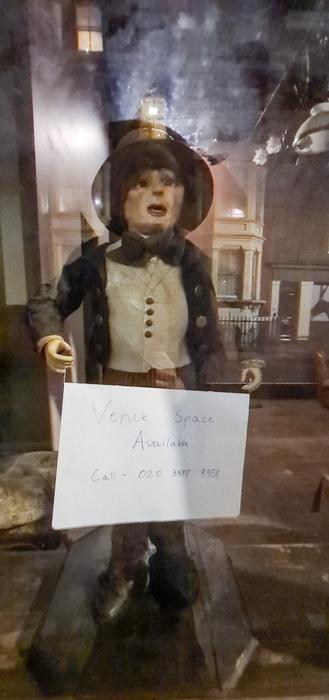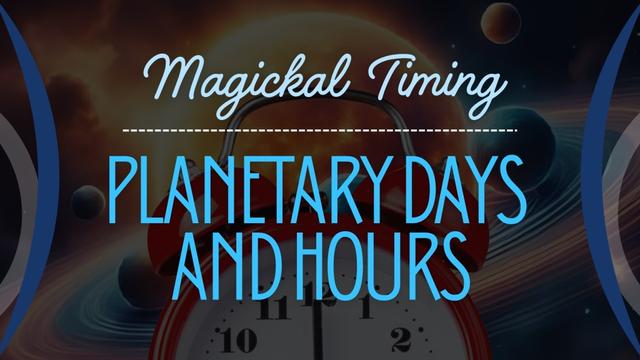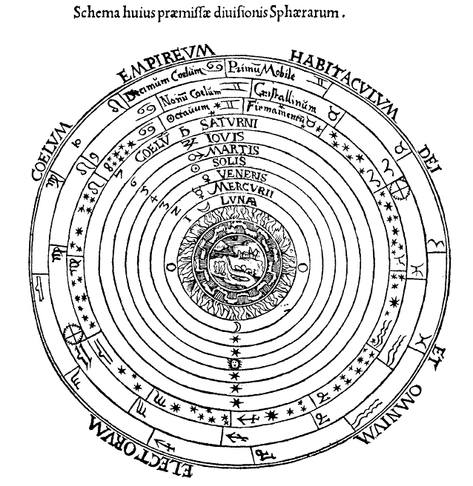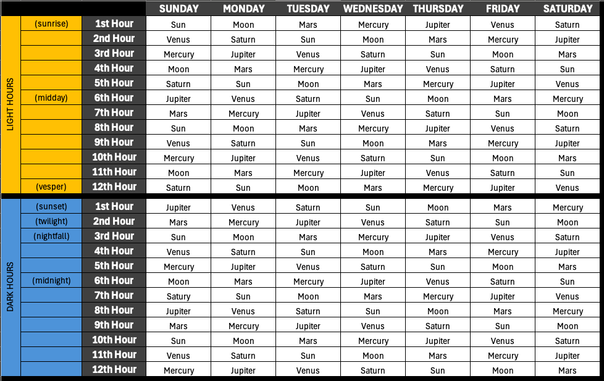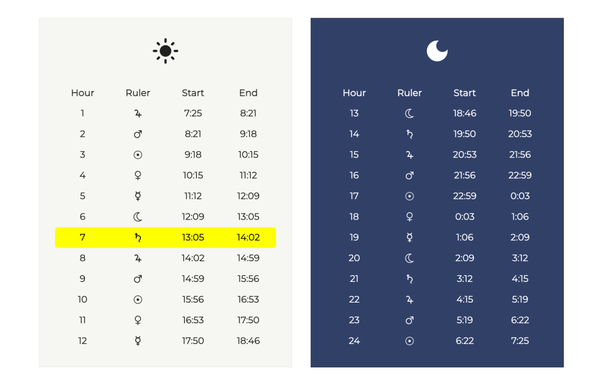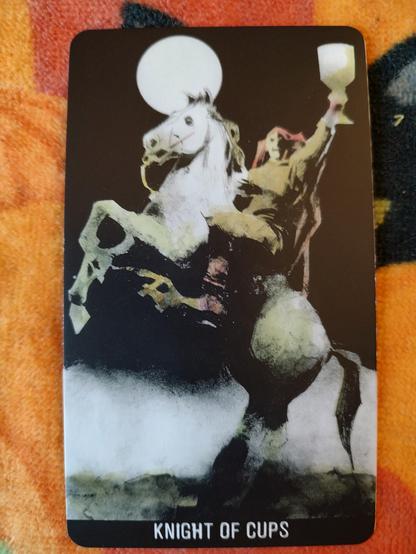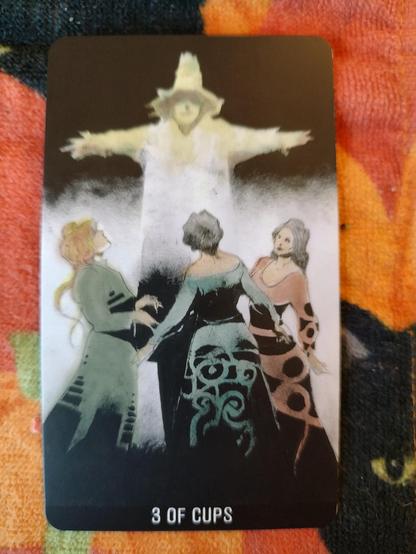Magickal Timing: Planetary Days and Hours Explained
When it comes to planning spellwork, rituals, or really any type of magickal adventures, there’s always the issue of timing. And while it might be tempting to do things when it’s most convenient, that isn’t necessarily the best energetic opportunity. On the topic of magickal timing, there are several factors to keep in mind including planetary timing, astrological schedules, and moon phases. Today we’re going to discuss my favorite of those three: Planetary Days and Hours.
The Basics of Planetary Timing
It’s widely acknowledge that each of the seven plants (Sun, Moon, Mercury, Venus, Mars, Jupiter, and Saturn) correspond to particular days and particular times. This is to say that the we can predict when the they will most strongly exert their influences on us and what we’re doing. And yes, while not considered “planets” by modern science, the Sun and Moon were treated as such by the ancients.
The Babylonians were the first to catalog the visible bodies that moved across sky. They didn’t know that the sun was a star and that the moon was… well, a moon in orbit around us. They pretty much just saw seven things that were 1) bigger than the other things and 2) moved differently than the other things. Naturally, they assumed they were each significant.
The Chaldeans then arranged the planets in an order based on the relative speed at which they appear to move across the sky from our perspective here on Earth. The order, frequently called “Chaldean Order,” is Saturn, Jupiter, Mars, Sun, Venus, Mercury, and Moon. This is slowest to fastest, so Saturn appears to move the slowest and the Moon appears to move the fastest.
Do you want some help remembering that? Feel free to use this stupid mnemonic device: Space Just Makes Stars Visibly Manifest Movement.
Chaldean Order also represents the arrangement of the planetary spheres that surround earth. That’s a slightly unrelated topic to what we’re discussing today, but it’s still cool to think about.
Planetary Spheres as depicted in Cosmographia by Peter Apian, 1539. Public Domain.
The Greeks and Romans adopted these ideas, then slapped the names of their deities on the planets. It become further integrated into classical cosmology through the work of philosophers like Aristotle and astronomers like Ptolemy. The Ancient Greek word for planet—planētēs—literally meant “wanderer,” referring to how differently they moved from the “fixed” stars.
All of this was a very geocentric viewpoint of the universe. Everything revolves around us, blah, blah, blah. We’re so full of ourselves, aren’t we?
Want to hear about future posts? Subscribe to get notifications delivered straight to your inbox.
✓ Subscribed
It wasn’t until the 16th century that Nicolaus Copernicus proposed a heliocentric view of the universe—one in which we orbit the sun. And that really upset some people. It challenged Aristotelian physics and even some interpretations of the Bible. In fact, the Catholic church banned his book until 1835. Eventually, however, people discovered other planets… like Neptune. And now we know that My Very Eager Mother Just Sent Us Nine… of something. Wait, what did she send? I don’t know because Pluto isn’t a planet anymore.
Nonetheless, the classical views on the planets were a big hit in the occult world and those ancient teachings are still the basis for plenty of magickal viewpoints today.
Planetary Days
Anyone who doesn’t believe that Ancient Greek and Roman ideas are pretty much permanently assimilated into our society should potentially spend some time looking at a calendar. You probably already know this, but our days of the week are named after… yes, you guessed it, the planets. In English, this is pretty obvious with some days (I’m looking at you, SUNday) and less obvious with others.
Here’s the basic correspondence chart:
Day of the WeekOriginal LatinAssociated PlanetSundaydiēs SōlisSunMondaydiēs LūnaeMoonTuesdaydiēs MārtisMarsWednesdaydiēs MercuriīMercuryThursdaydiēs IovisJupiterFridaydiēs VenerisVenusSaturdaydiēs SāturnīSaturn
With seven planets and seven days of the week, you may think that our naming pattern should directly correspond with Chaldean Order, right? Wrong. I mean, that would have been convenient, though. The order of our weekdays is actually based on a slightly more complicated system of Planetary Hours, which we will discuss in a moment, but first: let’s talk about why you would use a planetary day in your spellwork.
Each of the planets is associated with a particular type of energy. Mars, for instance, is the planet of action, representing assertiveness, courage, and strength. The Day of Mars, Tuesday, would be a great day for magick that focuses on things like protection, overcoming obstacles, breaking bad habits, or motivating yourself… because those particular currents of energy would be working in your favor.
It would not necessarily be a good day to do a love spell, however, because Mars is also the planet of conflict and aggression. Those ideas are counterintuitive to the idea of love, which would be much better suited for being worked on a Friday, the Day of Venus.
Does that mean you can’t do Venusian magick on a Tuesday…. or Martian magick on a Friday? No, absolutely not. You can do whatever you want, whenever you want… but as a witch, magician, wizard, or woo-woo worker of any sort, you should be aware of the forces around you at any given moment that can help or hinder your magick. If you just had to do that love spell on a Tuesday, then you better be prepared to put a little extra oomph into it.
It’s not really my intention here to give you an exhaustive list of planetary correspondences, but I’ll at least get you started.
PlanetCorrespondenceSuggested MagickSunsuccess, fame, wealth, and self-expressionconfidence, creativity, career advancement, and healingMoonintuition, emotions, and psychic abilitiesfertility, releasing negative emotions, divination, and inner wisdomMarsaction, courage, and conflictstrength, protection, breaking bad habits, and overcoming adversariesMercurycommunication, travel, and businesscommerce, learning, contracts, and finding solutions to problemsJupiterexpansion, abundance, and prosperitymoney, fortune, personal or business growth, and ambitionVenuslove, beauty, and pleasureromance, friendship, relationships, and creative pursuitsSaturndiscipline, restriction, and karmagrounding, purification, banishing, binding, and understanding patterns
Okay? Have you got the basics down? Good. Because now we’re going to multiply the complexity by seven.
Planetary Hours
If you think of Planetary Days like the main focus of energy on any given day, then a Planetary Hour is a lens that further refines aspects of that energy. If Planetary Days were types of frozen desserts, like gelato, frozen custard, and ice cream… then Planetary Hours are flavors… strawberry, chocolate, and vanilla. You can have strawberry gelato or you could have chocolate gelato. It’s all gelato, but it’s refined into a particular flavor. Is anyone hungry?
Just like there is a Day of the Sun, there is also an Hour of the Sun… and that hour can occur on any day — in fact, it occurs at least twice on every day.
Planetary Hours are the things that are responsible for determining the order of our days. And they follow Chaldean Order. The thing is… they’re not like our normal clock hours of 60 minutes. Calculating them is really cumbersome and… like… literally no one ever does it by hand. But you should still understand how they work.
The first hour of any day always determines the name of the day. The first hour of a Sunday is always the Hour of the Sun. The first hour of a Saturday is always the Hour of Saturn. That part is easy. What’s a little harder to determine, realistically, is that that the first hour of a day occurs when the first rays of sunlight stretch over the horizon—basically, dawn. That’s going to change slightly every day.
We’re going to divide the day into two sections: light (which spans from sunrise until sunset) and dark (which spans from sunset until sunrise the next day). It’s an important distinction here that the day begins at dawn, not at 12:00am. If you were planning to do some spellwork at 3am, for instance, your calendar might say Monday, but technically that’s still the Planetary Day of Sunday.
Here’s the first step:
SUNMONTUEWEDTHUFRISATLIGHT HRSLIGHT HRSLIGHT HRSLIGHT HRSLIGHT HRSLIGHT HRSLIGHT HRSDARK HRSDARK HRSDARK HRSDARK HRSDARK HRSDARK HRSDARK HRS
For each day, there will be 12 hours of light hours and 12 hours of dark hours. We’ll need to divide our chart up again, but remember… a Planetary Hour is not the same thing as a clock hour. They are almost never exactly 60 minutes long. Additionally, our Daylight Planetary Hours are going to be slightly different from our Night Planetary Hours.
Trigger Warning: Math
In order to calculate the length of our Light Planetary Hours, we’ll need to measure how many minutes there are from SUNRISE to SUNSET and then divide that number by twelve. I’m going to use the date of this post (10/23/2025) and my current location (Florida) as a working example. The location matters, yes, because the sun rises at different times in different parts of the world. And yes… the date matters because our amount of daylight changes significantly between Autumn Equinox and Spring Equinox.
The sun rose at 7:25AM today. It will set at 6:44PM. That’s 679 minutes. Divided by twelve, that means each of my Light Planetary Hours will be about 56 minutes long… I’m rounding for simplicity. From the 6:44PM sunset to sunrise the next day at 7:25AM, there are 761 minutes. Divided by twelve, that means that each of my Night Planetary Hours will be about 63 minutes long… again, rounding for simplicity.
At first glance, that might seem odd, but it actually makes sense. We’re in October in the Northern Hemisphere, so our nights are slightly longer than our days.
Let’s go back to our chart… wait… I’m going to have to open up Excel for this…
If you start in the Hour of the Sun on Sunday, then follow Chaldean order to add sequential planets a total of 24 times, you will end with the Hour of Mercury as the final period of the day. You know that’s correct because the next planet in the sequence is the Moon, which will start the light hours on Monday, the next day. Remember, the first hour of any day always begins with its governing planet. And that’s how we get the order of days.
Don’t miss out. Here’s what’s coming up…
More Info Now that you have that handy chart to reference, all you have to do is perform some simple arithmetic to fill in the times. Sunrise today was at 7:25AM. My light hours are 56 minutes long. That means that my first planetary hour today begins at 7:25AM and ends at 8:21AM. It’s a Thursday so the corresponding hour would be Jupiter. My second planetary hour, corresponding to Mars, begins at 8:21AM and ends at 9:18AM. So on and so forth.
I’m not going to do that all for you because… the internet does it for me.
You can go to websites like this one to have all the information calculated automatically. Can you imagine doing it by hand regularly? It sucks, but you should probably try it out once or twice so that you can make sure you really understand what’s going on.
Traditionally, the strongest resonance of any planetary energy is thought to be on the first hour of its designated day, ie – The Hour of the Sun on a Sunday, the Hour of the Moon on a Monday… in both cases, at dawn.
You can see from the above screenshot that Hour 7 is highlighted because that’s currently when I’m writing this. Maybe instead of writing, I should be organizing my blog. My website is a personal growth project — that totally fits the theme of Thursday’s Jupiter energy. If I wanted to refine that lens a little bit, the energy of Saturn is frequently associated with structure and organization. In that sense, organizing a personal growth project fits perfectly within the Hour of Saturn on the Day of Jupiter.
Ruling the Night
There are some schools of thought that believe that the dark hours of each 24 hour period (Planetary Nights) start a new pattern of energy with a new ruling planet, regardless of what the day was. By these accounts, the planet initiating the dark hours will hold the strongest vibration of energy for that 12 hour period.
If we extend that idea out, then there are actually two separate points within a week that will give extra oomph to each individual planetary powers.
- SUN: Sunday at Dawn or Wednesday at Sunset
- MOON: Monday at Dawn or Thursday at Sunset
- MARS: Tuesday at Dawn or Friday at Sunset
- MERCURY: Wednesday at Dawn or Saturday at Sunset
- JUPITER: Thursday at Dawn or Sunday at Sunset
- VENUS: Friday at Dawn or Monday at Sunset
- SATURN: Saturday at Dawn or Tuesday at Sunset
Since the SUN initiates (meaning it is the first in a 12-hour series) the Planetary Day hours on Sunday and the Planetary Night hours on Wednesday, its energy is strongest at those two times.
As for all of the other combinations of planetary energies on different hours of various days, I will leave the interpretations up to you. It can get pretty subjective.
Consider:
- What might you focus on during the Hour of Mercury on a Thursday vs. the Hour of Mercury on a Friday?
- What might you focus on during the Hour of the Sun on a Tuesday vs. the Hour of Saturn on a Tuesday?
In Practice
Sometimes you have to do magick, either out of necessity or timing requirements, that doesn’t fall within these convenient boxes. With our coven schedule, for instance, we meet regularly on certain weekdays and at a particular time, so it’s really just not practical for us to let the Planetary Day define our ritual. Still, if we’re doing magick for communication and we happen to notice that the Hour of Mercury is starting 45 minutes after our gathering time, then we’ll most likely delay the ritual so we can better align ourselves with that energy. If you have the ability and knowledge, then why not use as much of it as possible?
Wrapping your head around magickal timing can be quite an undertaking at first, but it will start to come more naturally as your use it more often. As Christopher Penczak told me, “start small” — that’s what I repeat to everyone as advice. Try something, see how it feels, and if you think it helped, do it more often. If you think it didn’t help, move onto something else and return to try it again at another point in your life.
If you’d like to go deeper into other aspects of magickal timing and correspondences, by the way, I’ve got almost an entire chapter dedicated to it in my book: Fluid Condensers. It’s not out yet, but you can pre-order!
#magick #magickalTiming #occult #planetaryDays #planetaryHours #planetaryMagick #spellwork #spirituality #timing #witch #witchcraft

